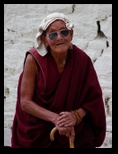
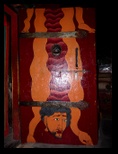
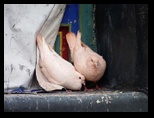
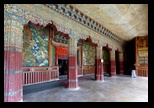
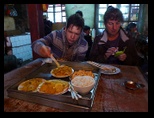
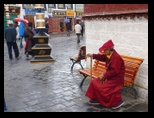
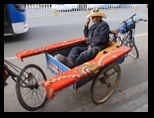
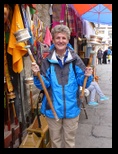
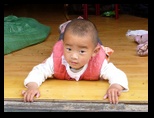
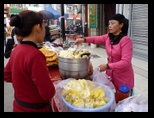
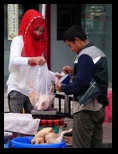
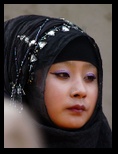
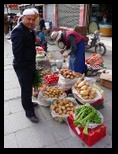
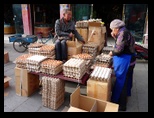
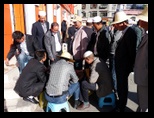
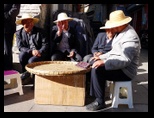

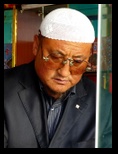
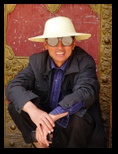
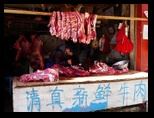
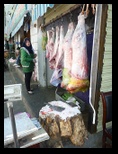
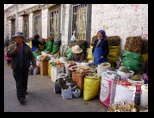
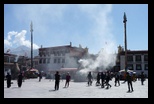


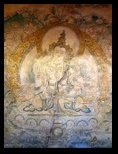

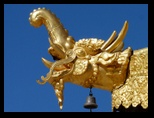


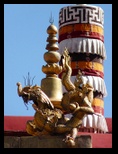

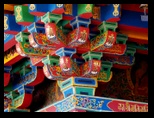
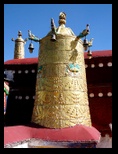
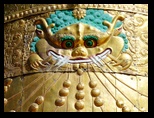
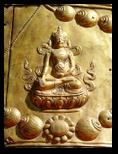
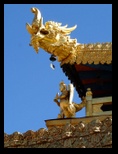
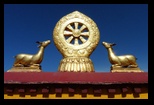



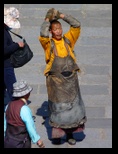
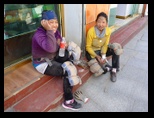
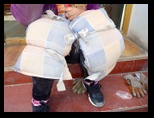
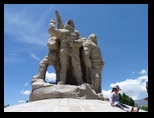
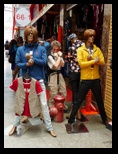
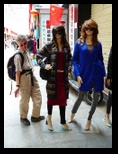
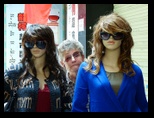
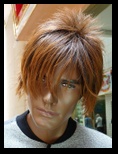

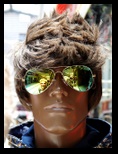
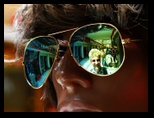

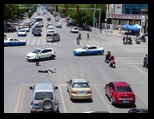
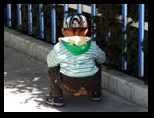
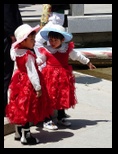
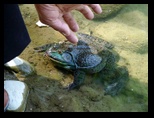

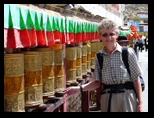
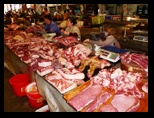
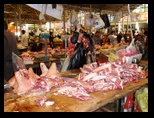
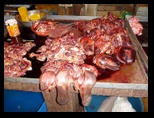
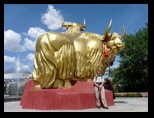
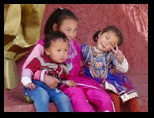
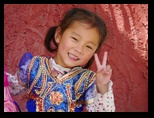
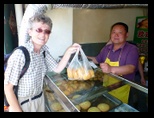
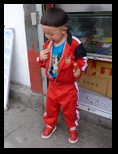
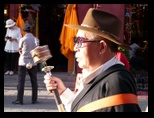
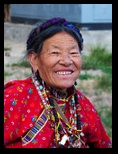

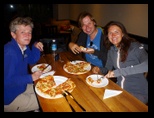

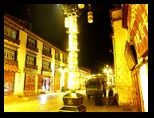 Steintore
Steintore
Click on a photo to enlarge it.
Fri, 30.05.2014: Lhasa, sunny/rain, 24°C
There were two monasteries on our sightseeing list for today - Drepung Monastery and Sera Monastery.
We drove out to Drepung Monastery which was one of the world's largest, built in 1416. Drepung means "rice heap" referring to the large number of white buildings on the hillside. In 1417 there were 2,000 resident monks but now there are around 600.
Garden Palace was built in 1530 and was the home of the 2nd to 4th Dalai Lamas until the 5th Dalai Lama built Potala Palace. The Assembly Hall is the principal building housing the kitchen with medieval looking giant cauldrons.
We climbed up lots of steps to get to the monastery and then waited for Bar who decided to climb a few hundred more to get to a viewpoint. He got lost though, so we waited over 30 minutes for him before we could go inside.
There were Dalai Lama tombs, numerous chapels and even more Buddhas. Once again we would have to pay to take photos inside and the fees were prohibitive. There was, however, one impressive glass case containing 1,000 Buddhas, dressed in colourful silk clothing and with blue hair in a style that looked like small balls on top of each head. The display looked new even though our guide told us that the Buddha were 100 years old. The clothing and hair looked so colourful and bright that it was difficult to believe their age.
There were lots of winding, narrow lanes between the numerous buildings as we walked downhill to the exit.
Our next stop was to have lunch at the monks restaurant at Sera Monastery before going inside. We were all looking forward to eating there but were truly disappointed. The place was filthy - mud floors covered in detritus from previous guests, dirty tables - and the food was terrible. The scalloped potatoes were fiery hot with chillies, the momos (steamed vegetable packets) were too chewy and contained unknown ingredients that didn't look very appetizing. Several begging children were around and one grabbed Kirsten's wallet. Kirsten swatted the kids hand away and told her "No". The word would have been incomprehensible to the child but not the sentiment!
Anyway, I went into a small shop next to the restaurant and bought yoghurt and biscuits to eat on the outside tables. The others followed suit, even our guide, who admitted she didn't like the food there! Okay, so it sounds like a great idea and looks good on the itinerary but it failed miserably!
Sera Monastery was founded in 1419 and once had 5,000 monks. It has 300 today. The main assembly hall was built in 1710 and contains a 6 metre high statue of Jampa.
Normally tourists are allowed to watch the monks debating outside in the afternoons but it was pouring down with rain so there were no debates that day. At least we managed to sit and listen to the monks chanting and being served with their lunch - rice in plastic bags and yoghurt served in bowls that they ate with their fingers.
We went into a couple of the chapels but only spent 40 minutes there. I think we were all getting a bit bored by seeing the same thing over and over again. Three days of monasteries, Buddhas and Lamas was getting overwhelming!
Tibet Tour Part 4 - Lhasa (Drepung & Sera Monasteries, Muslim Quarter)
We went out to a restaurant and shared a pizza for our meal and then bought some cakes from a small, hole in the wall bakery and ate them as we walked along the street. They were so good that we turned around and went back for more. The owner positively beamed at us as we used hand signals and sounds to say they were delicious. I think we made his day!
Sat, 31.05.2014: Lhasa, sunny, 24°C
We said goodbye to Bar and Claudie who had flights back to Kathmandu and then were joined for breakfast by Tiziana and Laurent, the Swiss couple from the other Jeep. They spent a night at Gyantse which is what our original plan had been, instead of driving to Lhasa the same day. This meant that they had far better weather coming over the high passes and got some great photos of Yamdruk Lake with it's beautiful turquoise blue colour.
We walked to the Ani Sangkyung Convent which is called a nunnery here to see if the nuns were chanting. But not today, so we walked off to see Jokhang Temple. We had been given the entrance fee money by our guide as it was included in the tour but we had opted to postpone the visit until today. We were allowed to go there on our own.
Jokhang Temple is the most revered religious structure in Tibet and houses the most revered Buddha - the Jowe Buddha that is 1.5 metres high. It was built between AD 639 to 647 (estimated dates) and was restored in 1980 after being damaged during the Cultural Revolution. The forecourt is perpetually crowded with pilgrims and we battled with the huge crowds.
No photos are allowed but it would have been difficult to get good shots - very dark inside; jostling crowds; and getting choked from the incense smoke and yak butter! It was enough to bring on claustrophobia!
There were an untold number of chapels and shrines on both the ground and first floors but you could get fresh air up on the roof. We spent about 90 minutes there and were free to wander on our own instead of being pushed through as part of a group. We enjoyed our freedom!
We took a leisurely walk back to the hotel through the streets and an indoor market and watched people buying medicine from straw platters. After a quick lunch in our hotel room we went on a 3.5 mile walk to see the Everest Mountaineers statue, the Golden Archer statue (which we never found!), had fun with dummies in the street outside all the fashion shops, and then went to Zang Gyab Lukhang Park with it's small pools, and various children having fun on boats and in air balls.
We also walked around the outside of Potala Place and went to see the Golden Yak statue and another indoor market. We bought more cakes from our smiling baker and met up with Tiziana and Laurent for a meal in the evening.
Tibet Tour Part 5 - Lhasa (People and markets)
It had been another long day but we were looking forward to our next adventure on the highest train in the world!